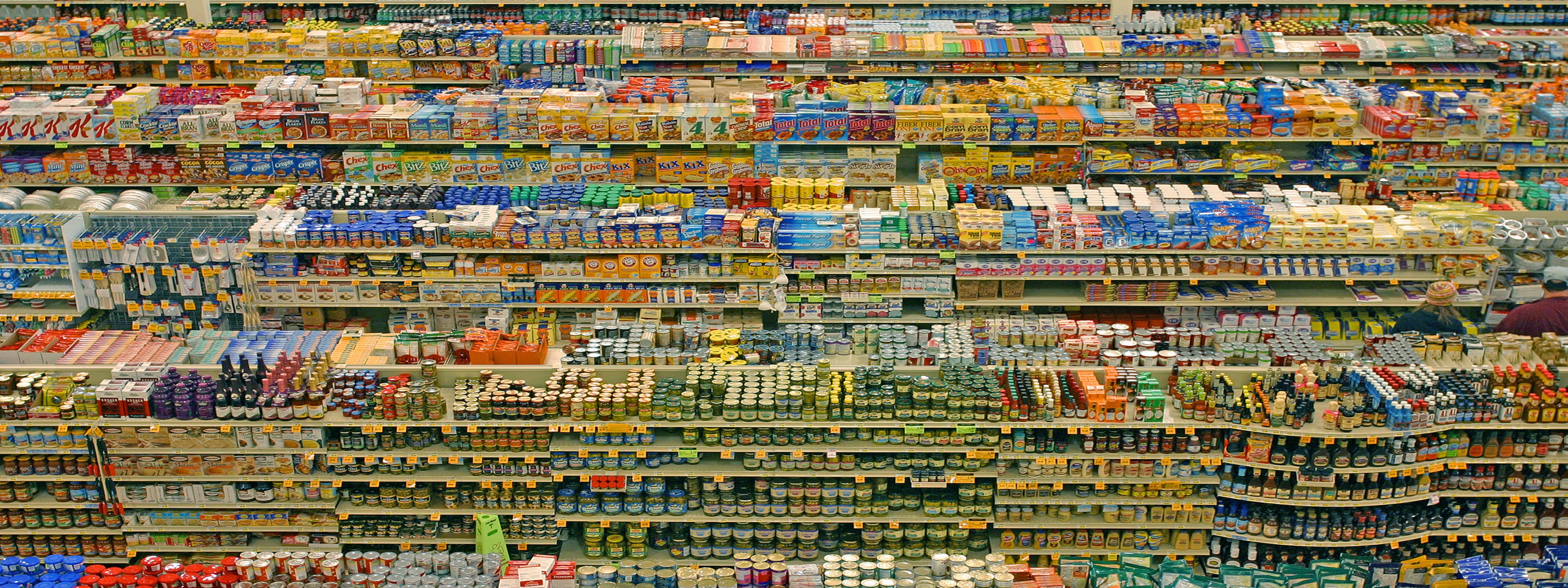There is something not quite right here, in my opinion. Norway only has three large supermarket chains, which is a cause for concern for suppliers.
Professor Leif E. Hem, Department of Strategy and Management

Norwegian food producers need to find more ways to sell their products outside the major chains, claims professor Leif Egil Hem.
"If the suppliers are so unhappy with the big chains, they ought to think outside the box and try to find the best way to connect with the consumers. Sell the brands directly! If they do not pass this test, then perhaps their products are not up to scratch," says professor Leif Egil Hem.
He has conducted research into branding and management at NHH's Department of Strategy and Management for several years.
Hem is positive towards chains' own brands, because they challenge the suppliers in terms of quality and price, but nevertheless believes that the chains are pushing the limits in their use of so-called "private labels" to put pressure on the suppliers.
Therefore, it is high time, he claims, that the primary producers take matters into their own hands.
"I have been waiting for a long time for the food producers to find a way to avoid the big retail chains."
There is something not quite right here, in my opinion. Norway only has three large supermarket chains, which is a cause for concern for suppliers.
Professor Leif E. Hem, Department of Strategy and Management
Hem refers to Stein Erik Hagen's online food store marked.no as a prime example. It was launched in January, with effect from February. The focus here is on national Norwegian brands. The consumers can buy groceries online and have them delivered to their doorstep from a central warehouse.
Other similar concepts include Adams matkassa, godtlevert.no and Kolonial.no.
The supermarket chains have recently started marketing and selling their own brands far more proactively. This puts pressure on the producers of national brands.
"Now several food producers have realised that they need to find alternative ways of reaching their customers."

In 2014 we bought groceries for NOK 160 billion. Virtually everything was bought in a shop – a trend that the chains want to see continue in the future too. When we buy online, our purchases are more carefully planned and less impulsive, meaning less money for the shops.
Earlier this year, the Norwegian daily newspaper Aftenposten ran a story about an advertisement published by the supermarket chain Rema 1000 recommending that customers do not buy sausages from a specific, named supplier, but rather go for the chain's own brand.
"Switch from Gilde's hotdogs to Nordfjord's sausages and save 20.3% per kilo", the advertisement stated.
"There is something not quite right here, in my opinion. Norway only has three large supermarket chains, which is a cause for concern for suppliers. The chains have in-depth knowledge about the consumers' purchasing patterns and have a lot of information about the suppliers. This makes the competition very tough."
In recent years, there has been a boom in the chains' own-brand products, Hem says, and the primary producers are struggling to keep up. This is a development that clearly favours the chains.
Many producers believe that their goods are being unfairly outcompeted.
It is the chains that set the price of all the goods sold in their outlets, meaning the suppliers have little power in the competition between their products and the chains' own brands.
"Primary producers have to both collaborate with the chains as partners and compete with them as rivals. This makes for a very demanding situation. What makes it extra difficult and irritates the producers is when the chains start saying 'buy our own brands – they are cheaper than the supplier's branded labels.' Here the chains are crossing a line," says Hem.
He believes this could ultimately lead to questionable practices. The chains can promote and sell their own brands far more cheaply than goods from the primary producers. This may even involve cross-subsidisation, which is when the chains sell an item at such a low price that they actually lose money on the sale and use the profit from sales of a supplier's product to cover the loss on their own brand."
Cross-subsidisation only exists when the prices of own-brand products are so low that they do not cover the production costs. It is not illegal for chains to offer their own products at a lower price than the suppliers' products.
Chains' offering their own brands is not a new phenomenon, but never before have Norwegian shops had such a wide range of private labels.
"They make up at least 13–14% of the total turnover. If you include fresh meat, fruit and vegetables – product categories where private labels do particularly well – this figure rises to 30% of the turnover. With sales in the grocery trade of approximately NOK 160 billion a year, this adds up to a lot of money."
The range of private labels is increasing all the time, because the three grocery chains in Norway have cracked a number of codes and are doing much better than before, according to Hem.
This phenomenon is not unique to the grocery industry – it is happening in every industry where chains are strong and want to take a larger share of the value chain without being dependent on the primary producers, such as sports and electronics chains.
"In several cases, the chains are buying up the production stage – Rema 1000 acquired the chicken company Stange kylling. They then have control over the entire value chain from raw materials to the customer."
Retail chains have tried to introduce their own brands several times over the years, says Hem, but without success. The 1970s saw the advent of blue and white goods in shops.
"It did not work, however, because the chains were small and there were so many individual shopkeepers. Production was too small, so it did not pay. The following decade was quieter, with Rema 1000 and Rimi growing steadily and the arrival of a newcomer – Coop.
The 1990s saw heightened competition between the chains.
"Today it is all about taking percentages from each other. All the chains have their own brands, and Coop in particular has made this a key element of its profile."
The producers have to relate to the chains in a completely different way today.
"In the 1970s, the primary producers were so large that they could dictate terms to the shopkeepers. The shopkeepers approached the producers almost cap-in-hand when they wanted to buy goods. Today it is the other way round. The producers are struggling to get a foot in the door and get their products on the shelves, and then they face tough competition from the chain's own products."
Hem finds that consumers have become much more positive towards private labels. Just a few years ago, own brands were generally regarded as cheap and low quality.
"Own brands are no longer a low-cost phenomenon. Now we have private labels at three levels: the cheapest, such as First Price, an intermediate segment with brands such as Eldorado, and a premium series of high-price, high-quality products, such as NorgesGruppen's brand Jacobs."
In many cases, the customers do not even realise that they are buying the chains' own brands.
"Many people think that the premium goods from Jacobs come from an independent supplier, but this is an example of how the chains have learned from the primary producers how to build their own brands. Segmentation provides something for everyone: cheap products for bargain hunters and top-end products for people who want higher quality.
Hem has found that older consumers are often slightly negative to private labels. They want Gilde and Tine and safe, familiar brand names.
"But when I ask students at NHH, they say that the chains' own brands may not taste as good, but when a cheap item costs a third of a competing product, the choice is easy."
Nowadays the individual chain knows so much about its customers that they can tailor solutions for them that make them prefer the chain's own goods. Customers develop a high degree of loyalty to the chains and the chains' own brands.
"You start getting used to Coop coffee and start buying Coop crisps, beer and a variety of other items from the chain. Maybe you get a discount on the chain's goods and special offers on the chain's card. They steer you more and more towards buying their own products. Then the chains start to gain more detailed knowledge of the customers, which they use to draw them even closer."
"Nevertheless, many people argue that we have too many low-cost outlets with a poor range of goods?"
"The reason for this is that the chains are good at giving us a focus. Virtually all their communication is about price, and we are affected by this marketing communication. When the focus is almost exclusively on price, we think price. Only exceptionally does the market communication focus on quality and variety in their range of products."
"Do we become more price-sensitive in bad times?"
"In economic downturns, the chains' own brands sell better, because they are normally cheaper. When money is tight, many people opt for the cheapest goods. But what happens is that we get used to these brands, and we are loyal to them and do not stop buying them, even though the economic situation has improved."
"If the primary producers think this is unfair, that they are being treated badly – and they are certainly being squeezed hard – then they must take matters into their own hands. If they are not reaching their consumers, they can follow marked.no's example."
The Norwegian Inquiry Commission for the Power Relations in the Food Supply Chain's power analysis from 2011: "The powerful and the powerless of the food supply chain" highlighted the pressure on the suppliers.
According to the Commission, most small suppliers have a short life span, while the medium-sized suppliers see limited opportunities for further investments in their original brands and often consider switching to production of the chains' own brands. The large suppliers report that they have to enter into exclusive agreements with the chains to ensure predictability.
Concentrating on online trade is one solution to these challenges, and the professor thinks this is an exciting and very promising move.
"If it really takes off, they will be able to offer their products at a lower price than the chains, which have invested heavily in stock, logistics and employees," Hem concludes.